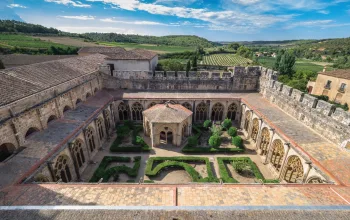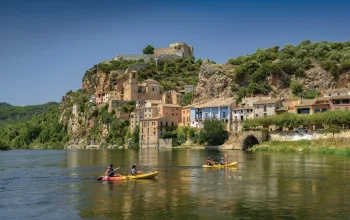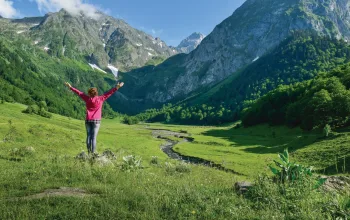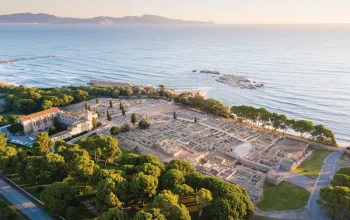Leg 4: Ode to Nature
Route: La Seu d’Urgell to Figueres
Distance: 357km
Duration: 5 stages

History, art and nature feature heavily in this leg, which takes in the village that inspired Picasso, the paths of exile of the Cathars, enchanted forests that were a refuge for poets and a landscape formed by dozens of volcanoes. You’ll pass through medieval villages and discover the culinary secrets of many Catalan recipes, before ending the leg in Figueres, home town of another great artist, Salvador Dalí.

Stage 1: La Seu d’Urgell to Baga
Distance: 90km
Take some time before continuing your journey to visit the Cathedral of Santa Maria, in La Seu, the only fully Romanesque cathedral in Catalonia. From here the road is a panoramic drive to Gósol, meandering through pine forests and past picturesque high-altitude villages.
In Gósol, you can wander past houses painted by Picasso, or maybe walk part of the route travelled by the Cathars in the Middle Ages, as they fled the persecution of the Inquisition. The day ends in Bagà, with a chance to taste delicious Catalan dishes such as potatoes with black pudding!

Stage 2: Baga to Ripoll
Distance: 128km
Head into the region of La Cerdanya, with its 17 municipalities above 1,000m. The route passes through Puigcerdà, a town perched alongside a beautiful lake, as well as a collection of villages with short strong names such as Urtx, Alp and Das.
In the afternoon, make time to visit Castellar de N’Hug, the source of the Llobregat river, that flows through Catalonia from the Pyrenees to the Mediterranean. Journey’s end for this stage is in Ripoll.
Don't miss: In the Footsteps of the Cathars
The GR107 or Cam í Cathars is a trans-Pyrennean itinerary along the migration paths used by the Cathars, in the 13th and 14th centuries, when they were fleeing from the Inquisition. As critics of the Catholic Church and the feudal system of the time, they were considered heretics and persecuted by order of the French king.
The entire 189km itinerary starts at the Queralt Sanctuary, in Berga, and ends at the Montsegur castle, located in the Ariège region of France. In the town of Bagà you can visit the Catharism Interpretation Centre, to learn about the history of this religious community which settled in the historic region of Occitani

Stage 3: Ripoll to Olot
Distance: 75km
Starting point is Ripoll’s monastery of Santa Marí a de Ripoll, founded in 879, with characters carved in stone – known as the Stone Bible. From Ripoll head to Ribes de Freser where you can take the rack railway to the picture-perfect head of the Vall de Núria and follow a walking trail or horse ride to the Verge Forest. Back on the road, the route heads through Camprodron – home of some famous artisan cookies – and several other beautiful villages towards Olot.
Don't miss: A Wintry Pioneer
The ironically-named Alp has an especially interesting tale to tell… At the beginning of the 20th century, people were already skiing in La Molina, but the arrival of the railway in 1922 was what stimulated the arrival of skiers to this modest Pyrenean resort located in the municipality of Alp, in La Cerdanya.
The first ski lift in Spain was installed here, in 1943, and shortly after, in 1946, La Molina again showed its credentials as a pioneer in the installation of lifts with the launch of the Turó de la Perdiu chairlift. Today, the skiable domain totals 71km on 68 slopes.

Stage 4: Olot to Banyoles
Distance: 30km
You’ve arrived at a unique place in the province – the volcanic landscape of the Natural Park La Garrotxa, and the best way to view this spectacular terrain is either from the air, with a hot-air balloon ride, or by cycling part of the Greenway of Carrilet de Olot.
Spend some time also getting to know Olot with its wonderful market, full of local delicacies, including sausages and chocolates. Banyoles offers the chance to spend a night under the stars…
Don't miss: Land of volcanoes
The Garrotxa’s Volcanic Zone is the best example of volcanic terrain on the Iberian Peninsula. It has 40 volcanic cones and more than 20 lava flows. The vegetation here reflects the climate. While in the Alta Garrotxa and the east of the county you’ll find typically Mediterranean vegetation, the rest of the county is covered with sub-Mediterranean vegetation that becomes Atlantic in the most humid parts.
Holm oaks are typical on the sunny hillsides of the east, with relatively dry, hot summers. The oak tree dominates in other parts, and the beech is found in the most humid sectors. On the Olot plain, the most characteristic species is the common oak. One of the jewels of the Garrotxa is the Croscat cone – the youngest volcano on the peninsula, and walking trails enable you to get up close.

Stage 5: Banyoles to Figueres
Distance: 34km
The lake of Banyoles, midway between the Pyrenees and the flat plains of the Empordà offers an ideal opportunity for a change of pace by exploring the highly photogenic fisheries that dot the shoreline in a kayak. From Banyoles, the road runs through pine forests to the noble town of Besalú, with its magnificent Romanesque bridge over the River Fluvià and well-preserved 13th century synagogue.
The day, and the stage, ends in Figueres, home town of Salvador Dali, where you can follow in some of his early footsteps.
To find out more about this leg of the Grand Tour, go to grandtour.catalunya.com























